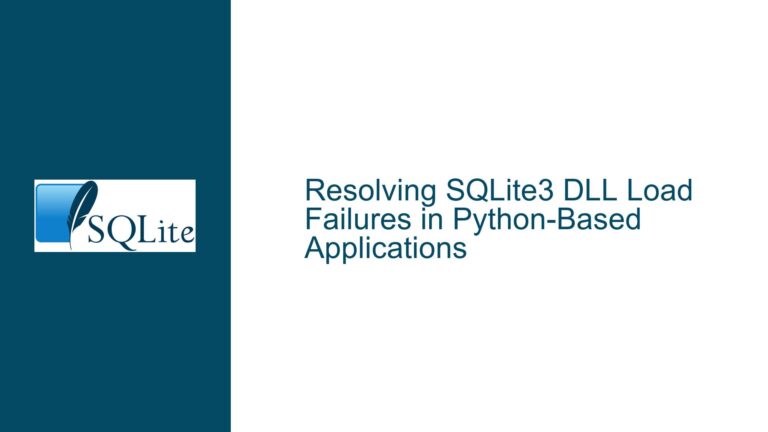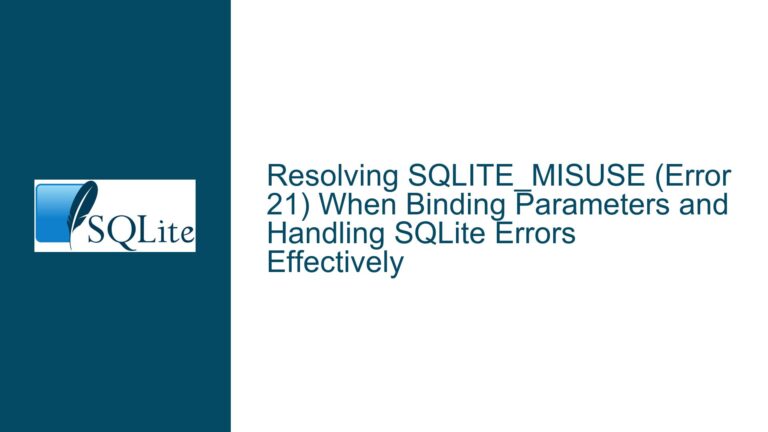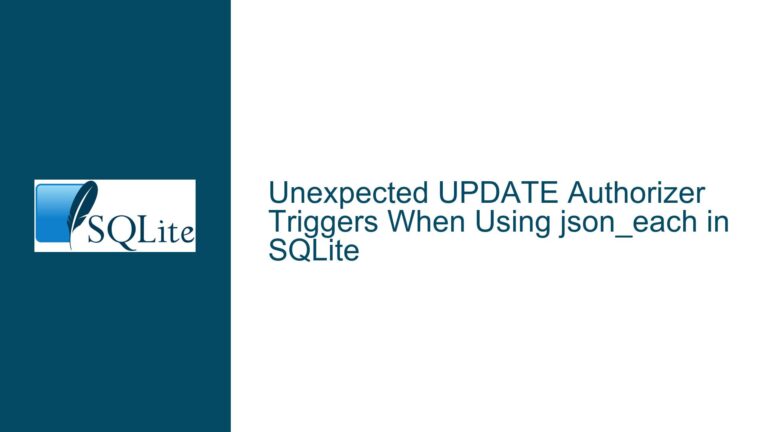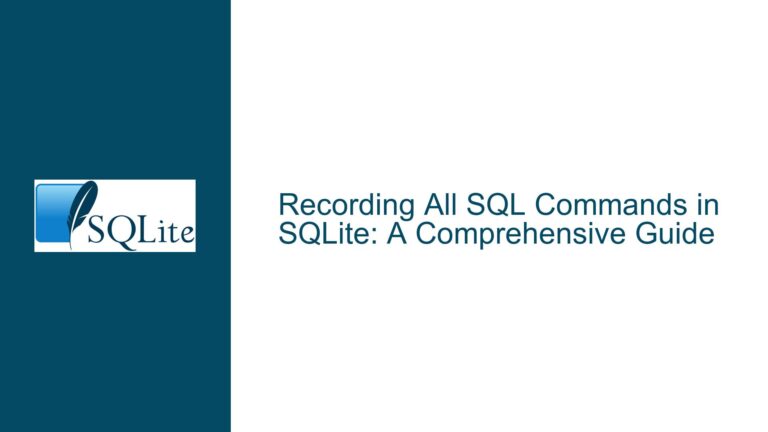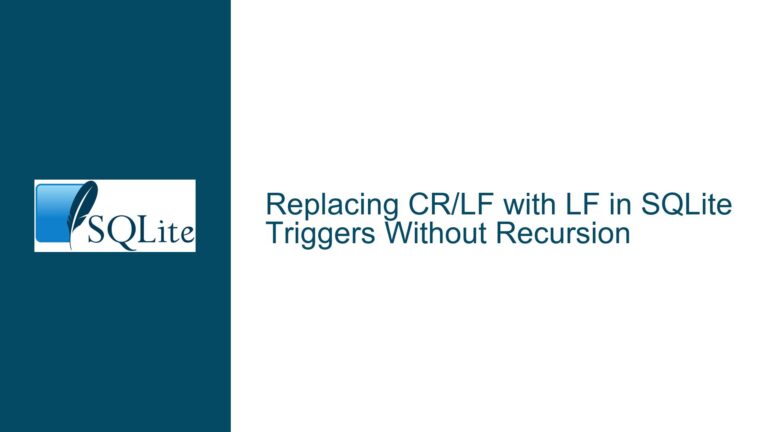SQLite Transaction Isolation and Schema Changes
Issue Overview: Transaction Isolation and Schema Changes in SQLite
SQLite is renowned for its lightweight, serverless architecture and robust transactional guarantees, including serializable transaction isolation. However, the behavior of schema changes within transactions, particularly when multiple connections are involved, can lead to unexpected outcomes if not properly understood. The core issue revolves around how SQLite handles schema modifications (e.g., CREATE TABLE, DROP TABLE) and the transactional isolation guarantees provided during these operations.
In SQLite, schema changes are transactional, meaning they can be rolled back if the transaction fails. However, the interaction between schema changes and concurrent transactions can be nuanced. For instance, when one transaction creates a table and another transaction attempts to interact with that table before the first transaction commits, the behavior may seem inconsistent with the expectation of serializable isolation. Specifically, the second transaction might encounter a "no such table" error during statement preparation, even though the table creation is part of an uncommitted transaction. This raises questions about the transactional boundaries of schema changes and how SQLite enforces isolation during such operations.
The confusion often stems from the distinction between statement preparation and execution. SQLite separates these two phases: preparation involves parsing and compiling the SQL statement, while execution involves actually reading from or writing to the database. Schema-related errors, such as "no such table," are typically detected during the preparation phase, which does not necessarily occur within the transactional context. This separation can lead to scenarios where a transaction appears to observe inconsistent database states, even though SQLite’s serializable isolation guarantees are technically upheld.
Possible Causes: Why Schema Changes Appear Non-Transactional
The apparent violation of serializable isolation in schema changes can be attributed to several factors, primarily related to SQLite’s internal mechanisms for handling transactions and schema modifications.
Deferred Transactions and Lock Acquisition: SQLite’s
BEGIN DEFERREDstatement does not immediately acquire a lock. Instead, it defers lock acquisition until the first read or write operation. This means that a transaction started withBEGIN DEFERREDdoes not enter a transactional state until it performs an operation that requires a lock. If a schema change is made in one transaction and another transaction attempts to interact with the schema before the first transaction commits, the second transaction might not yet be in a transactional state, leading to schema-related errors during statement preparation.Statement Preparation vs. Execution: SQLite’s two-phase process for handling SQL statements—preparation and execution—plays a critical role in this behavior. During preparation, SQLite checks the schema to ensure that the referenced tables and columns exist. However, this check is not transactional; it relies on the current state of the schema, which may not reflect uncommitted changes from other transactions. If a schema change is in progress but not yet committed, a statement preparation in another transaction might fail with a "no such table" error, even though the table creation is part of an uncommitted transaction.
Schema Versioning and Caching: SQLite maintains a schema version to optimize schema-related operations. When a schema change is made, the schema version is updated, and other connections are required to re-parse the schema if they attempt to access it. However, this re-parsing occurs only during statement execution, not during preparation. As a result, a transaction might use a cached schema during preparation, leading to errors if the schema has changed but the changes are not yet visible to the transaction.
Immediate vs. Deferred Transactions: Transactions started with
BEGIN IMMEDIATEacquire a write lock immediately, ensuring that no other transaction can modify the database until the transaction commits. In contrast,BEGIN DEFERREDtransactions do not acquire a lock until they perform a read or write operation. This difference can lead to race conditions where schema changes in one transaction are not immediately visible to another transaction, especially if the second transaction is in a deferred state.
Troubleshooting Steps, Solutions & Fixes: Ensuring Consistent Schema Changes
To address the challenges associated with schema changes and transaction isolation in SQLite, developers can adopt several strategies to ensure consistent and predictable behavior.
Use
BEGIN IMMEDIATEfor Schema Changes: When performing schema changes, always useBEGIN IMMEDIATEto start the transaction. This ensures that the transaction acquires a write lock immediately, preventing other transactions from modifying the database until the schema change is committed. This approach eliminates the risk of race conditions where schema changes are not immediately visible to other transactions.Avoid Relying on Errors for Control Flow: Errors encountered during statement preparation, such as "no such table," should not be used to determine the state of the database. Instead, explicitly check the schema using queries against the
sqlite_schematable (formerlysqlite_master) before performing operations. For example, instead of attempting to insert into a table and handling the "no such table" error, first check if the table exists using aSELECTstatement.Validate Schema State Within Transactions: When working with multiple transactions that depend on the schema state, ensure that each transaction validates the schema state within its own transactional context. For example, if a transaction needs to create a table only if another table does not exist, use a
SELECTstatement to check for the existence of the other table within the same transaction. This ensures that the schema state is consistent and reflects the most recent changes.Use Schema Versioning for Migration: When migrating a database schema while the application is running, use a schema versioning mechanism to coordinate schema changes across transactions. For example, maintain a
schema_versiontable or use SQLite’suser_versionpragma to track the current schema version. Before performing schema-related operations, check the schema version to ensure that the transaction is operating on the correct schema.Handle Schema Changes Gracefully: If the application must handle schema changes dynamically (e.g., during a live migration), ensure that all transactions are designed to handle both the old and new schema. This might involve using conditional logic to switch between schema versions based on the results of schema validation queries. However, avoid relying on errors for control flow, as this can lead to inconsistent behavior.
Monitor and Debug Transaction States: Use SQLite’s
sqlite3_txn_stateAPI to monitor the state of transactions and ensure that they are operating as expected. This can help identify situations where transactions are not acquiring the necessary locks or are operating outside the expected transactional context.Consider Journaling Modes: SQLite’s journaling modes, such as Write-Ahead Logging (WAL), can affect how transactions interact with schema changes. In WAL mode, readers do not block writers, and writers do not block readers, which can improve concurrency but may also introduce additional complexity when handling schema changes. Ensure that the chosen journaling mode aligns with the application’s requirements for transaction isolation and schema management.
By understanding the nuances of SQLite’s transaction isolation and schema change mechanisms, developers can design robust applications that handle schema modifications consistently and predictably. The key is to avoid assumptions about the transactional behavior of schema-related errors and instead rely on explicit schema validation and careful transaction management.

